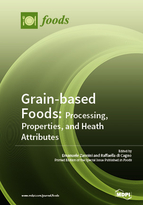Grain-based Foods: Processing, Properties, and Heath Attributes
A special issue of Foods (ISSN 2304-8158). This special issue belongs to the section "Grain".
Deadline for manuscript submissions: closed (31 March 2018) | Viewed by 70774
Special Issue Editors
Interests: lactic acid bacteria; fermented foods; precise nutrition; FODMAPs; plant protein bioprocessing
Special Issues, Collections and Topics in MDPI journals
Interests: molecular microbiology and biotechnology of vegetable/fruit, sourdough and cheese lactic acid bacteria; synthesis of biogenic compounds by lactic acid bacteria; transcriptomics and phenomics of lactic acid bacteria in response to plant niche environments; phenolics, fatty acids, phytochemicals; human intestinal microbiome in response to dietary habits
Special Issues, Collections and Topics in MDPI journals
Special Issue Information
Dear Colleagues,
The journal Foods (ISSN 2304-8158) is currently running a Special Issue entitled "Grain-Based Foods: Processing, Properties, and Heath Attributes", for which we are serving as Guest Editors. The Special Issue aims to provides a complete exploration of the scientific principles related to processing, fermentation/malting, and nutrition of cereal grains. It also describes their physical and chemical characteristics and explains how these properties relate to health and nutritional value of the final grain-based products. Indeed, while grains remain the world’s largest food yield—with more than 2.4 billion metric tons produced annually—consumer demands are on the rise for grain products sustainable from an environmental, social and economic viewpoint, in order to meet the growing demand for healthy and nutritious foods.
Given your precious and valuable knowledge in the area of cereal science, we would like to invite you to contribute with your expertise to this Special Issue. It would be an honor to receive a contribution from you.
Dr. Emanuele ZanniniDr. Raffaella di Cagno
Guest Editors
Manuscript Submission Information
Manuscripts should be submitted online at www.mdpi.com by registering and logging in to this website. Once you are registered, click here to go to the submission form. Manuscripts can be submitted until the deadline. All submissions that pass pre-check are peer-reviewed. Accepted papers will be published continuously in the journal (as soon as accepted) and will be listed together on the special issue website. Research articles, review articles as well as short communications are invited. For planned papers, a title and short abstract (about 100 words) can be sent to the Editorial Office for announcement on this website.
Submitted manuscripts should not have been published previously, nor be under consideration for publication elsewhere (except conference proceedings papers). All manuscripts are thoroughly refereed through a single-blind peer-review process. A guide for authors and other relevant information for submission of manuscripts is available on the Instructions for Authors page. Foods is an international peer-reviewed open access semimonthly journal published by MDPI.
Please visit the Instructions for Authors page before submitting a manuscript. The Article Processing Charge (APC) for publication in this open access journal is 2900 CHF (Swiss Francs). Submitted papers should be well formatted and use good English. Authors may use MDPI's English editing service prior to publication or during author revisions.
Keywords
- Grains/cereals techno-functional properties
- Lactic acid bacteria/yeast fermentation
- Cereal chemistry
- Health-promoting grain products
- Sustainable production








